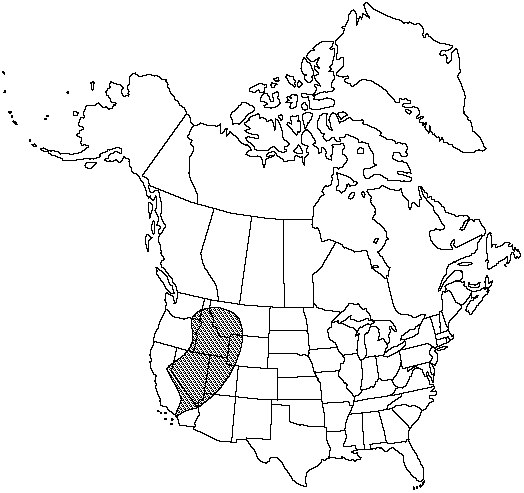Difference between revisions of "Botrychium crenulatum"
Amer. Fern J. 71: 21. 1981.
FNA>Volume Importer |
FNA>Volume Importer |
||
| Line 17: | Line 17: | ||
}}<!-- | }}<!-- | ||
| − | --><span class="statement" id="st- | + | --><span class="statement" id="st-undefined" data-properties=""><b>Trophophore </b>stalk 0.5–7 mm; blade yellow-green, oblong, 1-pinnate, to 6 × 2 cm, thin, herbaceous. <b>Pinnae</b> to 5 pairs, spreading, well separated, distance between 1st and 2d pinnae not or slightly more than between 2d and 3d pairs, basal pinna pair approximately equal in size and cutting to adjacent pair, broadly fan-shaped, undivided to tip, margins mainly crenulate to dentate, proximal pinnae with 1 or more shallow incisions, apex rounded, apical lobe linear to linear-cuneate, well separated from adjacent lobes, venation like ribs of fan, midrib absent. <b>Sporophores</b> 1–2-pinnate, 1.3–3 times length of trophophore. <b>2n</b> =90.</span><!-- |
-->{{Treatment/Body | -->{{Treatment/Body | ||
| + | |phenology=Leaves appearing in mid to late spring, dying in late summer; in extremely dry years of shorter duration or not appearing at all. | ||
|habitat=Local in marshy and springy areas | |habitat=Local in marshy and springy areas | ||
|elevation=1200–2500 m | |elevation=1200–2500 m | ||
| Line 39: | Line 40: | ||
|basionyms= | |basionyms= | ||
|family=Ophioglossaceae | |family=Ophioglossaceae | ||
| + | |phenology=Leaves appearing in mid to late spring, dying in late summer; in extremely dry years of shorter duration or not appearing at all. | ||
|habitat=Local in marshy and springy areas | |habitat=Local in marshy and springy areas | ||
|elevation=1200–2500 m | |elevation=1200–2500 m | ||
| Line 46: | Line 48: | ||
|publication year=1981 | |publication year=1981 | ||
|special status= | |special status= | ||
| − | |source xml=https://jpend@bitbucket.org/aafc-mbb/fna- | + | |source xml=https://jpend@bitbucket.org/aafc-mbb/fna-data-curation.git/src/9216fc802291cd3df363fd52122300479582ede7/coarse_grained_fna_xml/V2/V2_800.xml |
|genus=Botrychium | |genus=Botrychium | ||
|subgenus=Botrychium subg. Botrychium | |subgenus=Botrychium subg. Botrychium | ||
|species=Botrychium crenulatum | |species=Botrychium crenulatum | ||
| − | |||
| − | |||
| − | |||
| − | |||
| − | |||
| − | |||
| − | |||
| − | |||
| − | |||
| − | |||
| − | |||
| − | |||
| − | |||
| − | |||
| − | |||
| − | |||
| − | |||
| − | |||
| − | |||
| − | |||
| − | |||
| − | |||
| − | |||
| − | |||
}}<!-- | }}<!-- | ||
-->[[Category:Treatment]][[Category:Botrychium subg. Botrychium]] | -->[[Category:Treatment]][[Category:Botrychium subg. Botrychium]] | ||
Revision as of 13:28, 27 July 2019
Trophophore stalk 0.5–7 mm; blade yellow-green, oblong, 1-pinnate, to 6 × 2 cm, thin, herbaceous. Pinnae to 5 pairs, spreading, well separated, distance between 1st and 2d pinnae not or slightly more than between 2d and 3d pairs, basal pinna pair approximately equal in size and cutting to adjacent pair, broadly fan-shaped, undivided to tip, margins mainly crenulate to dentate, proximal pinnae with 1 or more shallow incisions, apex rounded, apical lobe linear to linear-cuneate, well separated from adjacent lobes, venation like ribs of fan, midrib absent. Sporophores 1–2-pinnate, 1.3–3 times length of trophophore. 2n =90.
Phenology: Leaves appearing in mid to late spring, dying in late summer; in extremely dry years of shorter duration or not appearing at all.
Habitat: Local in marshy and springy areas
Elevation: 1200–2500 m
Distribution

Ariz., Calif., Idaho, Mont., Oreg., Nev., Utah, Wash., Wyo.
Discussion
Botrychium crenulatum is commonly associated with B. simplex in California. In the Wallowa Mountains of Oregon it occurs with B. ascendens, B. lunaria, and B. minganense.
Selected References
None.